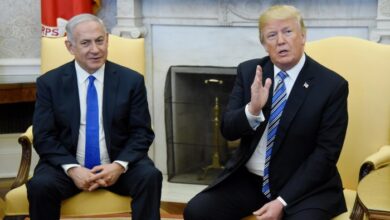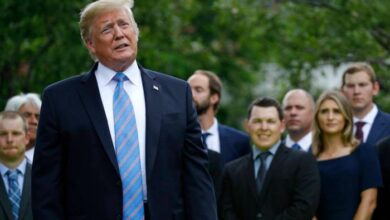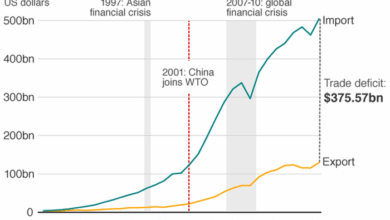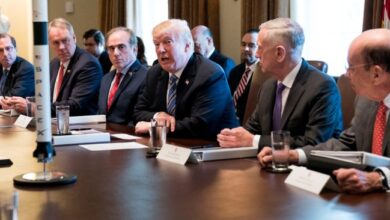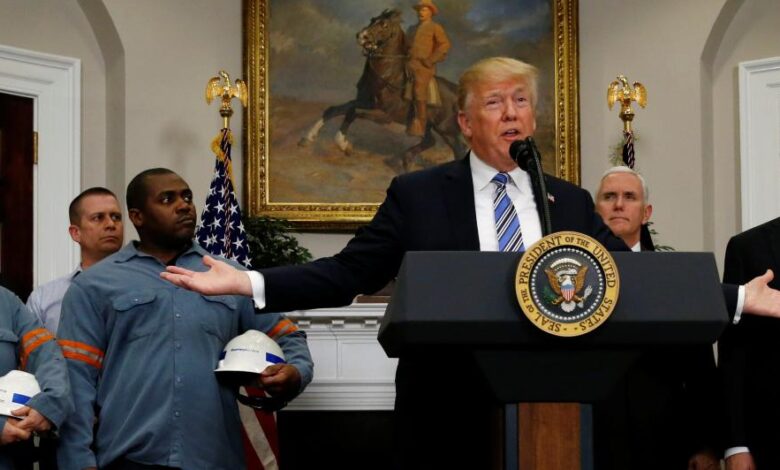
Federal Reserve chief says Trump tariffs likely to raise inflation, sparking a debate about the long-term economic consequences of protectionist trade policies. This analysis explores how tariffs can impact inflation, examining the Federal Reserve’s perspective and alternative economic interpretations. The potential consequences for consumers, businesses, and the overall economy are also considered, alongside illustrative case studies.
The article delves into the mechanisms through which tariffs affect inflation, including supply chain disruptions and increased input costs. It analyzes historical instances where tariffs were linked to inflationary pressures and considers the Federal Reserve’s response to such situations. A comparison of different tariff levels and their potential impact on inflation rates is also included.
Impact of Tariffs on Inflation
Tariffs, taxes imposed on imported goods, can significantly influence inflation rates. Their impact isn’t always straightforward, but understanding the mechanisms is crucial for assessing their overall effect on price levels. This analysis explores the intricate relationship between tariffs and inflation, considering supply chain disruptions, input costs, and historical examples. The Federal Reserve’s response to inflation is also examined in light of these tariff policies.Tariffs directly affect inflation by altering the supply and demand dynamics in the market.
Increased import costs due to tariffs push up the price of imported goods, leading to higher consumer prices. This effect ripples through the economy, impacting various sectors and ultimately influencing the overall inflation rate. Furthermore, tariffs can disrupt supply chains, leading to shortages and further price increases.
Mechanisms of Tariff-Induced Inflation
Tariffs act as a tax on imported goods, increasing their cost for domestic consumers. This price increase translates to higher prices for businesses that rely on those imported goods as inputs. Consequently, these businesses often pass the additional cost on to consumers, leading to a general rise in prices. This phenomenon is known as cost-push inflation.
- Supply Chain Disruptions: Tariffs can disrupt global supply chains, particularly when they target key inputs or components. This disruption leads to reduced availability of goods, increasing their scarcity and consequently driving up prices. For example, the imposition of tariffs on steel from China during the Trump administration impacted numerous industries relying on steel imports, resulting in increased costs for construction and manufacturing, and ultimately higher consumer prices for products using these materials.
- Increased Input Costs: Tariffs on raw materials, intermediate goods, and capital equipment used in production increase the cost of inputs for businesses. This can be observed in the automobile industry where tariffs on imported parts can affect the production costs of cars and lead to higher retail prices. This phenomenon often manifests as a rise in production costs, eventually reflected in the price of final goods.
Historical Examples of Tariffs and Inflation
Several historical instances demonstrate a correlation between tariffs and inflationary pressures. The Smoot-Hawley Tariff Act of 1930, a significant piece of legislation, is often cited as an example of how protectionist tariffs can exacerbate economic downturns. By increasing the cost of imports, it reduced trade and exacerbated the Great Depression. Similarly, the imposition of tariffs on various goods in recent years has prompted concerns about inflationary pressures.
The impact is complex and varies depending on the specific goods targeted and the overall economic climate.
The Federal Reserve chief’s warning about Trump tariffs potentially fueling inflation is definitely a concern. It seems like the whole situation is escalating with China announcing countermeasures, like raising tariffs on US goods, here’s a look at the details. This just adds another layer of complexity to the already precarious economic landscape, further reinforcing the Fed’s worries about rising prices.
Federal Reserve Response to Tariff-Induced Inflation
The Federal Reserve’s response to inflation, particularly when fueled by tariffs, involves several factors. The central bank monitors economic indicators, including inflation rates, to assess the impact of tariffs. Based on this assessment, the Fed might adjust monetary policy tools, such as interest rates, to manage inflation expectations and maintain price stability. The effectiveness of this response depends on the magnitude of the tariff impact and the overall economic environment.
Impact of Different Tariff Levels on Inflation (Hypothetical Data)
The table below illustrates the potential effects of varying tariff levels on inflation. Note that these are hypothetical figures and do not represent actual economic data.
| Tariff Level (%) | Estimated Inflation Rate (%) |
|---|---|
| 5 | 0.5 |
| 10 | 1.0 |
| 15 | 1.5 |
| 20 | 2.0 |
Federal Reserve’s Perspective on Tariffs
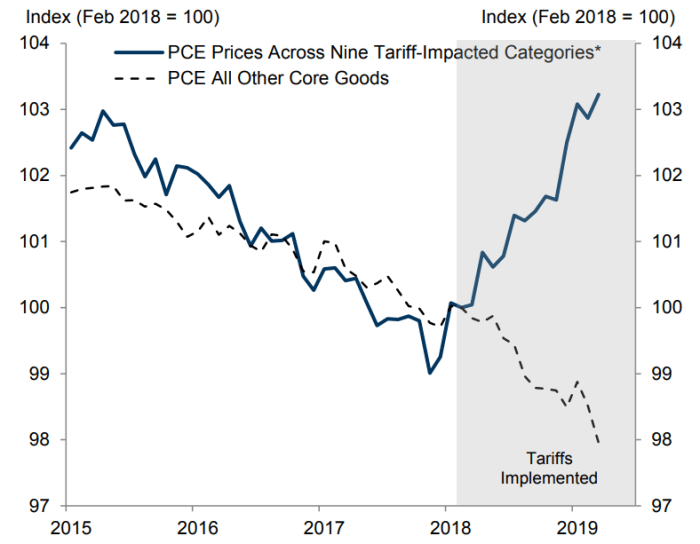
The Federal Reserve (Fed) plays a crucial role in managing inflation, and tariffs, as a form of trade policy, can significantly impact the economy, potentially influencing inflation. Understanding the Fed’s approach to assessing the economic impact of tariffs is essential for comprehending its response to this type of policy. This analysis delves into the Fed’s perspective, highlighting its considerations and potential policy responses to tariff-induced inflation.The Federal Reserve typically assesses the impact of tariffs by considering a wide range of economic factors.
These factors include the magnitude and scope of the tariffs, the industries and sectors affected, the potential for supply chain disruptions, and the overall economic conditions at the time. The Fed meticulously tracks price movements, examining changes in import costs, and analyzing the effect of tariffs on domestic production and consumption patterns.
Federal Reserve’s Approach to Assessing Tariff Impact
The Fed employs various tools and methodologies to evaluate the likelihood of inflation increases due to tariffs. Key considerations include the extent to which tariffs increase input costs for domestic businesses. For instance, tariffs on steel imports could raise the cost of steel for manufacturers, potentially leading to higher prices for consumer goods. Furthermore, the Fed analyzes how tariffs might impact aggregate demand.
If tariffs lead to retaliatory measures from other countries, trade volumes could decline, potentially reducing overall demand and moderating inflation pressures. The Fed also monitors the labor market, examining how tariffs might affect employment and wages. Changes in employment and wage trends can be a key indicator of the potential for inflationary pressures.
Factors Considered by the Fed for Inflationary Pressures
Several factors influence the Fed’s assessment of the potential for tariff-induced inflation. Import price increases directly stemming from tariffs are a key factor. The magnitude of the tariff, combined with the responsiveness of supply chains, plays a crucial role. Supply chain vulnerabilities are also considered, as tariffs can disrupt established trade flows and increase uncertainty for businesses.
The overall economic climate, including prevailing interest rates, consumer confidence, and overall demand, significantly influences the Fed’s analysis. The degree of pass-through from import prices to consumer prices also warrants attention. The responsiveness of businesses to higher input costs is a critical factor.
Potential Alternative Policy Responses
In response to tariff-induced inflation, the Federal Reserve has a range of policy tools at its disposal. One potential response is adjusting interest rates. If inflation rises above the Fed’s target, the central bank may increase interest rates to cool down the economy. Alternatively, the Fed might engage in quantitative tightening (QT), reducing the size of its balance sheet.
This action reduces liquidity in the financial system, potentially curbing inflationary pressures. Communication plays a critical role. Clear communication about the Fed’s assessment of the situation and its policy response can help manage market expectations and maintain economic stability.
Comparison with Historical Responses, Federal reserve chief says trump tariffs likely to raise inflation
The Fed’s current stance on inflation and its response to tariffs can be compared to historical episodes of trade protectionism and inflation. Examining previous trade wars and their impact on inflation can provide valuable insights into the potential consequences of current tariff policies. Historical data can inform the Fed’s current assessment and provide context for potential policy decisions.
The Federal Reserve chief’s statement about Trump tariffs potentially fueling inflation is definitely a worry. It’s making me think about those pre-week anxieties, those Sunday scaries, what are Sunday scaries , you know, the feeling of dread about the upcoming week. Hopefully, the market will stabilize and the inflation worries will subside, though the chief’s comments are definitely a cause for concern.
Channels Influencing Monetary Policy Decisions
| Channel | Impact on Monetary Policy |
|---|---|
| Import Price Increases | Increased import costs lead to higher domestic prices, potentially triggering inflationary pressures, prompting the Fed to consider interest rate adjustments. |
| Supply Chain Disruptions | Disruptions can affect production and distribution, leading to uncertainty and potentially higher prices. This might lead the Fed to monitor economic indicators closely. |
| Retaliatory Tariffs | International trade tensions can affect global demand and supply, impacting domestic inflation. This might influence the Fed’s outlook and response. |
| Reduced Trade Volumes | Decreased trade can lead to lower overall demand, potentially slowing economic growth. This could influence the Fed’s view on the appropriate monetary policy. |
| Changes in Aggregate Demand | Tariffs can shift aggregate demand, impacting inflation expectations. The Fed will consider this when evaluating policy options. |
Alternative Economic Interpretations
The Federal Reserve’s assessment of tariffs’ inflationary impact isn’t universally accepted. Different schools of economic thought offer contrasting perspectives on the relationship between trade barriers and price increases. These differing views highlight the complexity of analyzing the interplay between tariffs, supply chains, and consumer behavior. Examining these alternative perspectives reveals a multifaceted understanding of the economic consequences of protectionist policies.Different economic models offer varying insights into the inflationary consequences of tariffs.
Some models focus on supply-side factors, emphasizing the disruption to global supply chains and the resulting scarcity of goods. Others prioritize demand-side considerations, highlighting how tariffs might affect consumer spending and investment decisions. Understanding these diverse approaches is crucial for a comprehensive evaluation of tariff impacts.
The Federal Reserve chief’s warning about Trump tariffs potentially fueling inflation is certainly a concern. However, the increasing focus on US allied space forces, like the ones detailed on us allied space forces , might actually offer a unique avenue to potentially mitigate inflationary pressures. This could ultimately impact the Federal Reserve’s response to the predicted rise in prices, making it an interesting dynamic to watch.
Supply-Side Perspectives on Tariffs and Inflation
Supply-side economics emphasizes the role of production costs in determining prices. Tariffs, by increasing the cost of imported goods, can raise input prices for domestic businesses, potentially leading to higher final product prices. This can manifest in various ways, from higher raw material costs to reduced availability of intermediate goods. For example, tariffs on steel imports can impact the construction industry, leading to increased construction costs and potentially higher housing prices.
This impact can be further amplified if domestic industries lack the capacity to quickly substitute imported inputs.
Demand-Side Considerations and Inflationary Pressures
Demand-side economics focuses on consumer spending and investment as drivers of inflation. Tariffs can impact consumer spending patterns by altering the availability and prices of goods. For instance, tariffs on imported consumer electronics could reduce the availability of these goods or increase their prices, potentially affecting consumer demand for other goods and services. Furthermore, the uncertainty surrounding tariffs can discourage investment and potentially reduce aggregate demand.
Economists emphasizing the demand-side impact argue that the overall effect on inflation might be limited depending on the responsiveness of consumers to price changes.
Comparative Analysis of Economic Models
Different economic models offer varying strengths and weaknesses in evaluating the impact of tariffs on inflation. Supply-side models, while insightful in understanding cost-push inflation, might understate the role of demand-side factors and consumer behavior. Conversely, demand-side models, focusing on aggregate demand, might overlook the supply-chain disruptions that tariffs can induce. A comprehensive analysis of tariffs’ inflationary impact needs to consider both supply- and demand-side factors within a broader framework.
The Role of Supply and Demand in Determining Inflationary Effects
The interplay between supply- and demand-side factors significantly influences the inflationary impact of tariffs. Tariffs can increase input costs for domestic producers (supply-side), potentially leading to higher prices for consumers. Simultaneously, tariffs can reduce the availability of imported goods, potentially affecting consumer demand and overall spending (demand-side). The combined effect on inflation depends on the relative strength of these opposing forces.
For example, a tariff on a widely-used commodity might lead to a large supply-side effect, whereas a tariff on a less essential good might primarily impact demand.
Potential Consequences of Inflation
Tariffs, particularly those imposed on goods from other countries, can have a ripple effect throughout the economy, ultimately leading to inflationary pressures. Understanding the potential consequences of this rising inflation is crucial for businesses, consumers, and policymakers alike. The effects on various sectors, from manufacturing to services, can be significant and complex.
Impact on Consumers
Rising inflation erodes the purchasing power of consumers. Higher prices for goods and services mean consumers have less money to spend on other necessities and luxuries. This can lead to decreased consumer confidence and reduced spending, which can negatively impact economic growth. For example, if the price of essential food staples increases significantly, households may need to cut back on other expenditures, impacting their overall well-being.
Impact on Businesses
Businesses face challenges in a period of high inflation. Rising input costs, including raw materials and labor, can squeeze profit margins and reduce competitiveness. Companies may respond by increasing prices to maintain profitability, which further fuels inflationary pressures. Uncertainty about future price levels can also hinder investment and expansion plans. For example, a manufacturing company reliant on imported components will see its production costs increase, potentially leading to reduced output or higher product prices.
Impact on the Overall Economy
High inflation can destabilize the entire economy. Reduced consumer spending and business investment can lead to slower economic growth or even a recession. Uncertainty about future economic conditions can lead to a flight to safety, with investors moving money into less volatile assets like government bonds. This can further impact market liquidity and financial stability.
Impact on Employment
Inflation can affect employment in several ways. Businesses may reduce hiring or even lay off workers if they anticipate reduced demand or lower profits. On the other hand, increased demand for certain goods and services in response to inflation may lead to increased employment in those sectors. The overall impact on employment is typically negative as economic growth slows down.
Impact on Investment and Economic Growth
Inflation negatively affects investment and economic growth. Uncertainty about future price levels discourages investment in long-term projects. Businesses are less likely to expand or invest in new technologies if they cannot predict future costs or revenues accurately. Higher interest rates often accompany inflation, which further increases the cost of borrowing money, making investment more expensive and less attractive.
Mitigation Measures
Various measures can be taken to mitigate the negative consequences of increased inflation. Central banks can adjust monetary policy, such as raising interest rates, to cool down the economy. Fiscal policy measures, such as government spending cuts or tax increases, can also play a role in reducing demand-pull inflation. However, implementing these measures can be complex and have unintended consequences.
Potential Effects on Different Sectors
| Sector | Potential Effects of Inflation |
|---|---|
| Manufacturing | Increased costs for raw materials and labor, potentially leading to higher prices for manufactured goods, reduced output, and potential job losses. |
| Agriculture | Higher input costs (fertilizers, fuel) and potential supply chain disruptions, leading to higher food prices and reduced farm income. |
| Services | Increased costs for labor and other inputs, leading to higher prices for services like healthcare and transportation. |
| Technology | Increased costs for components and labor, potentially impacting the prices of technology products and services. |
Illustrative Case Studies
Analyzing the complex relationship between tariffs and inflation requires examining specific historical examples. While a direct causal link isn’t always straightforward, certain case studies offer valuable insights into potential inflationary pressures. This section delves into instances where tariffs were implemented, resulting in varying inflationary outcomes. The nuances of each case will be highlighted, allowing for a more comprehensive understanding of this economic dynamic.
Tariffs and Rising Inflation: The Case of the 2018 US-China Trade War
The 2018 US-China trade war, characterized by escalating tariffs on goods exchanged between the two nations, saw a noticeable increase in consumer prices. This increase wasn’t solely attributable to tariffs, but their impact on supply chains, reduced imports, and increased costs for businesses are considered significant contributors. Data from the Bureau of Labor Statistics showed a perceptible rise in the Consumer Price Index (CPI) during this period, reflecting broader inflationary pressures.
The 2018 tariffs, impacting sectors like technology and consumer goods, created ripples across the supply chain. Increased costs for imported components led to higher prices for finished products. Reduced import competition further exacerbated these price increases. While other factors like increased demand and supply chain disruptions played a role, the tariffs undeniably contributed to the inflationary pressures observed.
Tariffs and Stable Inflation: A Case Study of the European Union
European Union’s implementation of tariffs on certain goods from specific countries did not necessarily result in widespread inflation. Several factors played a crucial role. First, the tariffs were often targeted at specific industries, not impacting the broader consumer market to a significant degree. Second, EU nations have robust supply chains, allowing for alternative import sources. Finally, the European Central Bank maintained a stable monetary policy.
This case highlights the importance of considering the specific context and design of tariffs. Tariffs can be targeted, limited in scope, or even partially offset by other economic policies. The outcome depends on a complex interplay of factors, including the size of the affected market, the availability of substitute imports, and the overall macroeconomic environment. Importantly, robust supply chains can mitigate the impact of tariffs on inflation.
Tariffs Reduced, Inflation Declined: The 2001 Reduction in US Tariffs on Steel Imports
In 2001, the United States lowered tariffs on steel imports. This led to a decrease in the price of steel, impacting various industries that rely on steel. The reduced input cost trickled down to consumers, resulting in lower prices for finished goods. As a result, the overall inflation rate declined.
This case illustrates the inverse relationship between tariffs and inflation. Lower tariffs can reduce input costs, leading to lower prices for consumers. This effect is especially significant in sectors that use the affected imported goods as raw materials. Furthermore, increased competition from imports can put downward pressure on prices, directly influencing inflation.
Differentiating Factors in Case Studies
| Case Study | Key Differentiating Factors |
|---|---|
| 2018 US-China Trade War | Broad-based tariffs on numerous goods, disruption of supply chains, and limited alternative import sources. |
| EU Tariffs | Targeted tariffs, robust supply chains, and stable monetary policies. |
| 2001 US Steel Tariff Reduction | Reduced tariffs on steel imports, resulting in lower input costs and decreased consumer prices. |
The effectiveness of tariffs in influencing inflation is significantly dependent on various factors, including the scope of the tariffs, the availability of substitute imports, the strength of supply chains, and the overall economic environment. These case studies demonstrate the importance of considering these factors when evaluating the potential impact of tariffs on inflation.
Last Word: Federal Reserve Chief Says Trump Tariffs Likely To Raise Inflation
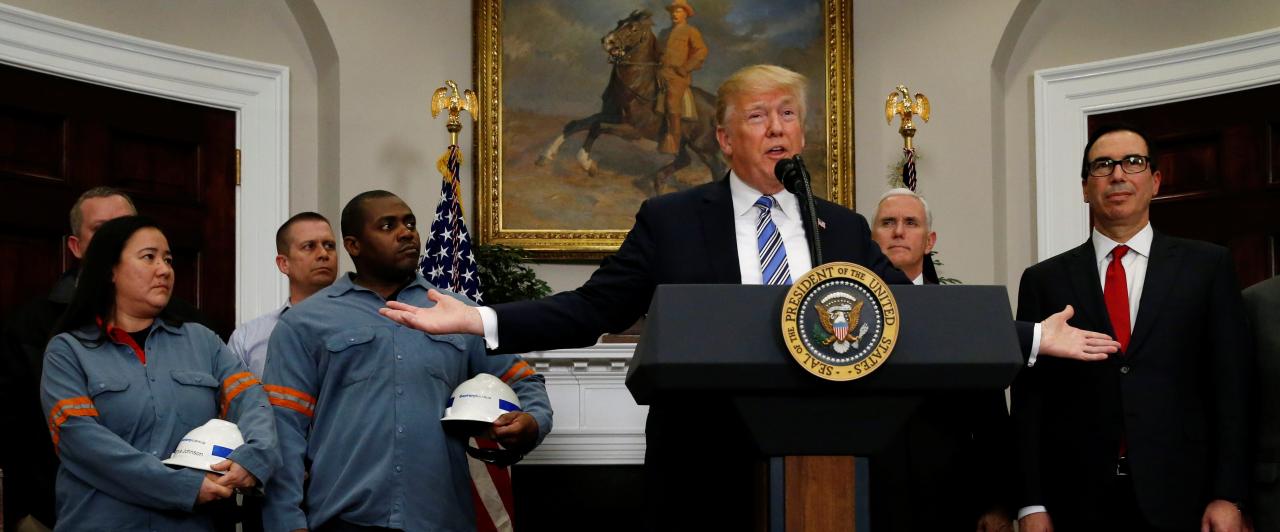
In conclusion, the potential for Trump tariffs to trigger inflation is a significant concern. The Federal Reserve’s assessment of this risk, alongside alternative economic viewpoints, highlights the complex interplay between trade policy and economic stability. Understanding the potential consequences for various sectors of the economy is crucial for policymakers and economic stakeholders. The provided case studies offer a glimpse into the varied outcomes of tariff implementation, emphasizing the need for a nuanced understanding of the situation.

